John Deere has unveiled a version of its 8R tractor equipped with autonomous driving tech that it claims will help solve world hunger. First premiered at CES in Las Vegas, the modified tractor pairs a GPS guidance system with 12 cameras that enable 360-degree obstacle detection.
All this means that a farmer can bring this tractor to one of their fields, set the machine to autonomous operation mode, and leave it to do its job. And that job can include ploughing, planting and spraying your crops – freeing you, the hardworking farmer, to do something else with your time.

And it’s for this reason that John Deere is touting this machine as the future of farming.
During a conference at CES, Jahmy Hindman, chief technology officer at John Deere, said:
“The world’s population is expected to grow from about 8 billion to nearly 10 billion people by 2050, increasing the global food demand by 50 per cent.
“Farmers must feed this growing world population, and it’s our job at John Deere to help them. The future of Agriculture starts now!”
And while that’s all very true — we are on the precipice of a global food emergency and have been for some time — is an autonomous tractor really the answer?
John Deere claims the autonomous tech can help farmers overcome the labour shortage they face. And so far, agricultural finance firm AG America, agrees that technology such as robotics and autonomous tech have been adopted by farmers for this very reason.
A report from the firm said:
“Smart farming technology allows farmers to work at full or near-full capacity with fewer workers, but not without certain drawbacks.”
The drawbacks of autonomous tech have brought about a shift in the produce grown in America, the firm said.
Such technologies have forced a move away from high-labour and precision crops, such as strawberries, broccoli, lettuce, and vine-ripe tomatoes. These crops are often, instead, imported into America instead of being grown here.
Instead, autonomous tech can alleviate the labour load on crops such as wheat and barley. Crops such as these can be planted, maintained and harvested with autonomous tech.
But if we must sacrifice our strawberries in order to roll out autonomous tractors, at least it will finally mark a useful implementation of autonomous driving.

As car makers continue to shout about the possibilities of a self-driving future, farming and other heavy machinery could instead be the real home of autonomous technology.
Sure, the Tesla fans will argue that that marque’s level 2 driver-assist system, called Autopilot, is a great on-road use of the technology. But many onlookers could point out to the issues its beta has faced so far. Maybe it’s the case that there are just too many variables and uncertainties for safe autonomous driving on busy roads?
Instead, ship this self-driving tech off to the farmland, where tractors will follow the same, straight paths every day. They won’t encounter rogue pedestrians crossing the road and won’t need to decide how to respond to a stop sign.
It really does make sense to use autonomous technology in situations like this.
